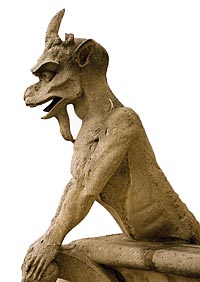Catalog of Horrors
Ghouls, demons, and giants — students trace the line between the human and the monstrous.
Somewhere in the heart of Christopher Livanos, there’s an adolescent boy dying for a good scare. A one-eyed cannibalistic giant, maybe. Or a vengeful reanimated corpse. Or the gaping maw of hell. But where, on the campus of a modern research university, can one find a convenient collection of horrors? In the great works of literature, naturally.
An associate professor of comparative literature, Livanos has devoted most of his career to studying the classical and early modern texts of the Byzantine Empire. But he’s always known there’s more to life than medieval Greek religious poetry.
“Like many boys, I was always fascinated with monsters,” he says. “Probably the first thing that drew me into Greek literature was the Cyclops.”
From this fascination was born Comparative Literature 203: Scary Monsters. Throughout a semester, Livanos takes students on a tour of the inhuman creatures that inhabit the canon of Western literature, from ancient epics (such as Gilgamesh, the Aeneid, and the Odyssey) to medieval poetry (including Beowulf and Dante’s Inferno). Some two hundred students enroll in the course each spring, attending Livanos’s two lectures and one T.A.-led discussion section each week.
Livanos believes that the monsters in these stories tell readers where the cultures that created the tales drew the boundary lines between the civilized and the bestial. “They tell us what it means to be human by showing us the opposite,” he says.

Christopher Livanos leads a discussion of the monsters found in J.R.R. Tolkien’s Children of Hurin, a modern novel that draws inspiration from medieval English and Scandinavian literature. Photo: Jeff Miller
For instance, the Icelandic Volsungasaga shows the importance that Norse culture placed on family ties — the monsters are those who violate ties of kinship. In Homer’s Odyssey, readers learn the sacred state of hospitality by comparison with the acts of the Cyclops, who eats his guests.
As the course develops, students move beyond the classics and into modern works to explore what today’s society considers monstrous. H.P. Lovecraft’s Mountains of Madness makes an appearance, as does J.R.R. Tolkein’s Children of Hurin, published in 2007, long after the author’s death. Past versions of the course have also included graphic novels, such as The Watchmen. Though the topic may seem like fun, the students are tasked with a ton of reading.
But then that’s indicative of Livanos’s love of monsters. “I like ’em all,” he says. “And though a lot of the teaching is from the canon, I want to be sure that we’ve got good stories. I decide on what texts I want to teach first, then just focus on what’s monstrous within them.”
Published in the Fall 2009 issue




Comments
No comments posted yet.